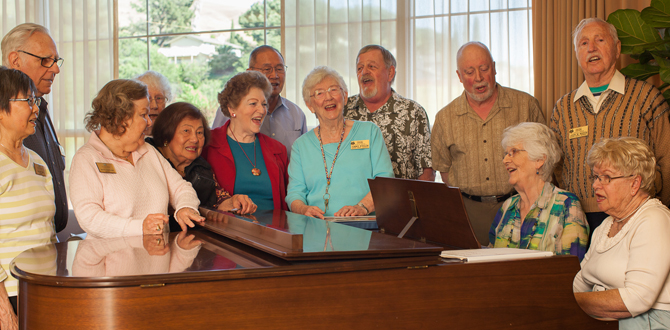Acacia Creek’s Musical Culture
Acacia Creek has a long musical tradition, thanks to residents’ interest in making music. On our campus, we are privileged to have many musicians – singers, pianists, ukulele and marimba players, Taiko drummers, and even songwriters.
Making Music Together
At least four pianos can be found on campus, including a player piano with music rolls donated by Susan Huff Guinn. Nancy Alden frequently provides piano music during dinner, delighting her audience by adding a touch of nostalgia and class to the dining room. Art Kimber tickles the ivories about every six weeks in his “Classics by Kimber” program in the Turkey Roost.
Three musical groups gather for weekly practice. Among them are the Acacia Creek Singers, directed by Nancy Alden. These 15 residents from Acacia Creek and the Masonic Homes serenade residents throughout our campus and also visit nearby residential communities. The Crooners carry on the “barbershop tradition” of blending male voices in four-part harmony, usually singing a cappella style. They are directed by Tom Caldwell and sometimes accompanied on the piano by Shirley Moore.
The latest addition to Acacia Creek’s musical scene is the Bell Choir – a group of Acacia Creek and Masonic Homes residents who play handheld brass bells in the old English tradition. This group began in 2016, when several residents expressed interest in learning how to play bells. Many participants began with no musical knowledge whatsoever, but thanks to the dedicated efforts of Masonic Homes resident Carole Silva, the Bell Choir played its first concert at the 2016 Tree Lighting, just three months after receiving the bells.
Melding Body and Mind
Each bell is tuned during the manufacturing process to produce a single note when rung by hand or hit with a mallet. The bells vary in weight and sound. Small bells tinkle softly and are easily played with a flick of the wrist. Larger bells have a lower pitch and are heavier, requiring steady wrist and arm movement.
Like other percussion instruments, playing bells requires a sense of rhythm and concentration. Bell players must keep time with the conductor’s direction and learn when to ring each bell. In order to play even a simple song, at least two octaves, with 12 bells per octave, are needed. (The Bell Choir plays on three full octaves.) Performers generally play two bells at a time, so they must remember which bell is which.
Music is an excellent brain fitness tool. In addition to increasing memory capacity, it also releases dopamine, the “feel good hormone,” and reduces stress. Making music is good for the soul, and humans have a natural tendency to benefit from it. At Acacia Creek, it offers another opportunity for residents to come together, socialize, and grow as individuals.
By Sophie Hudnut, Acacia Creek Resident




